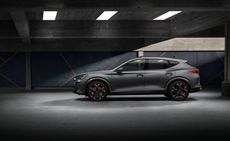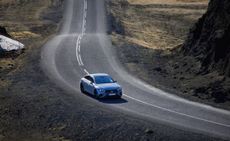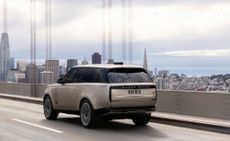New BMW iX is a bold statement for the future of EV design, inside and out
We test-drive the BMW iX, the brand’s new flagship electric vehicle and an extremely accomplished car
- (opens in new tab)
- (opens in new tab)
- (opens in new tab)
- Sign up to our newsletter Newsletter
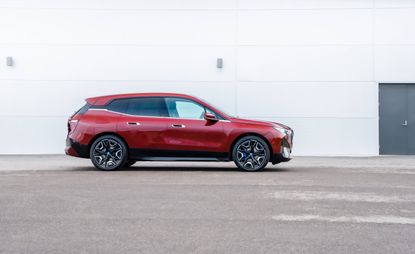
The new BMW iX has a certain devil-may-care swagger about it. BMW has been in the electrification game for far longer than other premium manufacturers, and although its strategy has been baffling at times, the company has always played the long game. The iX is a classic case in point. As the new flagship electric vehicle in BMW’s electric portfolio, it straddles categories, defies easy description, and offers up a challenging aesthetic proposition. It’s also an extremely accomplished car, electric or otherwise, with some bold design decisions that could only have come from a place of longstanding experience.

How did BMW get here? The BMW i3 and i8 were two of the very first standalone pure electric cars. Unveiled back in 2011 (opens in new tab) and introduced into the marketplace in 2013 and 2014 respectively, they were loudly acclaimed yet commercially unspectacular, failing to get the company a major toehold in the burgeoning EV market despite the many billions spent in R&D.
The little i3 is a fantastic car and can still hold its own against far more contemporary rivals. Production is due to end this summer, with around 250,000 units built. The i8, which was a plug-in hybrid sports car, as opposed to a pure EV, was also acclaimed for its styling, usability, and performance (opens in new tab). There was even a BMW i8 Roadster (opens in new tab). The last of just over 20,000 production cars rolled off the Leipzig production line in June 2020. If you catch sight of one today, you’ll see that the futuristic form remains quite unlike anything else on the road, now or then.

Perhaps due to the relative failure of the i3 and i8 in the marketplace, BMW pivoted its strategy and decided to integrate i-drive electrification into its mainstream models, rather than build standalone EVs. So far, there’s an iX3 electric SUV and the i4 sedan, with electrified versions of other key cars in the works, headed up by the new BMW i7, designed to go head-to-head with the Mercedes EQS (opens in new tab).
It can’t quite beat the EQS on range (the iX’s various versions offer between 341 miles and 392 miles), nor in sheer opulence of the interior. Instead, there’s a much more muted take on automotive technology, one that feels far less in your face.

For many people, the iX argument will be won or lost within seconds. This is a visually striking car, and not everyone will mean that in a positive way. The iX does look better in the metal than in photographs, but it is not going to win any beauty contests. For a start, that colossal grille dominates the front end. BMW (and to a lesser extent Audi and Mercedes) is seemingly on a quest to supersize its more identifiable characteristic. The so-called ‘double kidney’ has been an integral part of the BMW corporate identity since 1933. Since then, its application has veered from strict functionalism to elaborate over-emphasis.
The iX is clearly the latter, even if the ‘mesh’ itself is now an abstracted geometric panel. In functional terms, it’s where the car’s bevvy of sensors is housed, so it makes a certain sort of sense to make it such a prominent feature. Counterintuitively, BMW refers to this approach as ‘Shy Tech’, the art of concealing technology until it’s actually needed.

The rest of the body doesn’t so much flow back from this bold face as slide and slip in a chiselled, faceted kind of way. The tapering belt line that rises above the rear wheel to form a signature thick D-pillar was first seen in the i3 and has subsequently been widely imitated. In the iX, it seems to imply the end of the car, but there’s still a relatively large rear overhang.
The decision to narrow the head- and taillights into long horizontal bands is also at odds with the verticality of the grille.

And yet it sort of works. As a whole, the iX’s visual contradictions balance each other out, helped by some adventurous detailing and elements rendered in the optional Titan Bronze Exterior Trim. Visually, the iX has far more in common with the compact i3 than any of its SUV siblings; both EVs share the idiosyncratic discord that comes out from pushing the envelope.
For now, it’s still an outlier in the range, for it has no direct ICE-equivalent. Superficially, the iX sits in the same class as BMW’s other X-model SUVs, with the big X7 its closest relation (although it is closer in length to the X5 – it just looks bigger). But as we said, the i3 (and i8) still look fresh today because they broke free from the incremental evolutionary approach taken by the company’s other models.

The interior is one of the best premium spaces on the market. It makes the screen-heavy look of other contenders appear overly complex and busy. BMW has done much to pare back the surfaces without compromising function. As BMW head of design Domagoj Dukec (opens in new tab) told us last year, the iX ‘is a pivotal product for a whole new way of thinking about car design… we reduced the amount of interior elements. We offer more by doing less. This “mono material” approach shows more exclusivity than a traditional patchwork interior design.’
There is also more evidence of the Shy Tech approach, such as the click pad on the centre armrest, lovingly formed from a sliver of grainy wood, with the buttons for media and navigation imprinted onto its surface, along with the crystal glass iDrive controller. Crystal is also used for the adjustable seat buttons mounted on the doors, and the whole ambience is more akin to concept car than production model (the iX began life as the BMW Vision iNext shown at the 2019 Frankfurt Motor Show).

This less is more approach means that the little details delight. There are buttons instead of door handles. The mood lighting doesn’t go all-out superyacht-style but is reduced to graceful slashes of colour atop the doors. There’s electrochromatic glass in the optional panoramic roof (standard on the xDrive50 M Sport), which turns opaque at the click of a button.
The hexagonal steering wheel sounds gimmicky but works well in practice, and the optional Bowers & Wilkins Diamond Surround Sound Audio System shares the Shy Tech ethos by concealing its speakers subtly throughout the cabin. The processing speed of the big, television-like horizontal touchscreen is good and never feels like it’s trying to catch up. The interface is crisp and intuitive, although some of the graphical wallpaper choices might date faster than the rest of the car.

For the time being, luxury EVs have to be big in order to accommodate the range/battery-size equation that buyers associate with spending lots of money.
To use a mobile phone analogy, if the i3 is an original iPhone, then the iX is an iPhone 13 Pro Max: it takes a bit of getting used to but is hard to give up once you’ve adjusted to the change in scale.

There are also the clear performance benefits of electrification. 2022 marks the 50th year of BMW’s ‘M’ division. Petrol-powered models bearing the legendary M-prefix continue to be held in the highest esteem by the traditional enthusiast. The BMW i4 M50 is already on sale and a flagship iX M60 is in the works. For now, the top dog is the iX xDrive50 M Sport, which has 523hp and can do the obligatory 0 to 62mph sprint in 4.6 seconds. Power goes to all four wheels and the familiar sharpness of instant electric torque has not been blunted by the iX’s considerable weight.
The xDrive50 also has an impressive 380-mile range, with a clever efficiency drive mode that never feels like you’re being held back, unlike in other EVs. Sport mode also adds a ghostly science fiction-inspired ‘engine’ drone. Mention should also be made of the car’s soundscapes, which are triggered by turning the car on and off. These have been composed by none other than Hans Zimmer, king of the ominous cinematic crescendo.
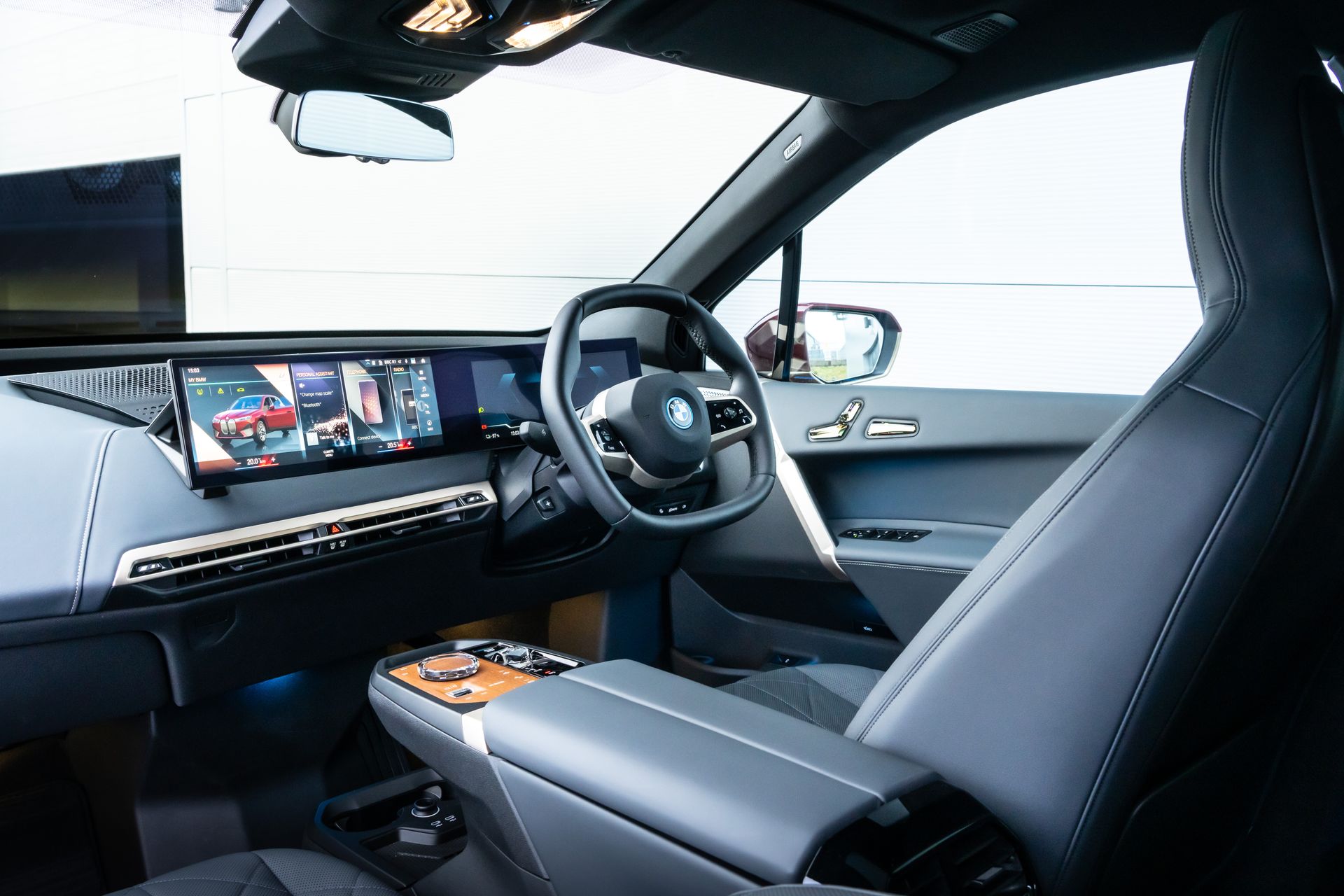
If you’re a habitual SUV driver, then the iX’s imposing (or challenging) looks and mighty stance won’t do anything to deter you, but for those who prefer to give off a less confrontational vibe, it might be a step too far. As a canvas for innovation, it’s second to none (we especially liked the recent iX-based Flow concept car with its e-ink surfaces). The BMW iX is hugely impressive on every level, with the interior alone putting it at the top of its class.
When BMW puts its focus solely on electrification, good things happen.
INFORMATION
BMW iX, from £69,905
Model tested BMW iX xDrive50 M Sport, £116,965 (with options)
bmw.co.uk (opens in new tab)
Jonathan Bell has written for Wallpaper* magazine since 1999, covering everything from architecture and transport design to books, tech and graphic design. He is now the magazine’s Transport and Technology Editor. Jonathan has written and edited 15 books, including Concept Car Design, 21st Century House, and The New Modern House. He is also the host of Wallpaper’s first podcast.
-
 Park House is a minimalist, art-filled family home in Melbourne
Park House is a minimalist, art-filled family home in MelbournePark House by Mim Design and Pleysier Perkins is an art-filled family home in Melbourne including a bold, concrete extension
By Nick Compton • Published
-
 Remembering New York artist Daniel Brush, 1947 – 2022
Remembering New York artist Daniel Brush, 1947 – 2022In tribute to Daniel Brush, who has died aged 75, we revisit this 2020 Wallpaper* profile of the elusive New York artist by jewellery historian Vivienne Becker, who unravelled the secrets of his singular designs for her book, ‘Daniel Brush: Jewels Sculpture’
By Vivienne Becker • Published
-
 Interior design books championing shelf love
Interior design books championing shelf loveWelcome to the Wallpaper* guide of the best interior design books published in 2022 and beyond – a collection of riveting visual tomes to feed creative innovation, inspiration and imagination
By Rosa Bertoli • Published
-
 BMW Motorrad brings out the big guns for its newest cruisers
BMW Motorrad brings out the big guns for its newest cruisersBMW Motorrad R 18 Bagger and Transcontinental set the tone for high-voltage cruising with a brand collaboration with speaker specialist Marshall
By George Chapman • Last updated
-
 Is McLaren’s GT a sports car, a tourer, or the best of both?
Is McLaren’s GT a sports car, a tourer, or the best of both?The McLaren GT is a capable all-rounder dressed up in svelte supercar clothes. It might also be the last of its type
By Jonathan Bell • Last updated
-
 The Cupra Formentor is a dark star for bright minds
The Cupra Formentor is a dark star for bright mindsFor all its moody styling, the Cupra Formentor – from the SEAT spin-off brand – is a compact, swift and fun-to-drive crossover
By Jonathan Bell • Last updated
-
 Hyundai Ioniq 6 EV is a sleek, stylish streamliner
Hyundai Ioniq 6 EV is a sleek, stylish streamlinerTake a first look at the Hyundai Ioniq 6 EV – stripped-back, streamlined, but retaining an interior that’s a ‘mindful cocoon’
By Jonathan Bell • Last updated
-
 Audi RS3 Sportback is tomorrow’s classic today
Audi RS3 Sportback is tomorrow’s classic todayIt may be one of the last of its ICE kind, but cars like the Audi RS3 Sportback represent the summit of a century’s evolution – and are a convincing reminder as to how far EVs still need to evolve
By Jonathan Bell • Last updated
-
 Mercedes EQE tiptoes around a revolution to inch EV design forwards
Mercedes EQE tiptoes around a revolution to inch EV design forwardsWe road test the new Mercedes-Benz EQE, the car that may ease the Mercedes E-Class customer into the electric age – balancing the formal experimentation that EVs allow with the familiar
By Nick Compton • Last updated
-
 The Bentley Continental GT Speed is distance divided by time, multiplied by luxury
The Bentley Continental GT Speed is distance divided by time, multiplied by luxuryThe Bentley Continental GT Speed more than lives up to the reputation of its forebears
By Jonathan Bell • Last updated
-
 Range Rover’s positive reboot: the best 4x4 flagship?
Range Rover’s positive reboot: the best 4x4 flagship?‘Less thrusting and more soothing’: we take a drive in the new-for-2022 Mk5 Range Rover and find it smoothed and refined, inside and out
By Guy Bird • Last updated





